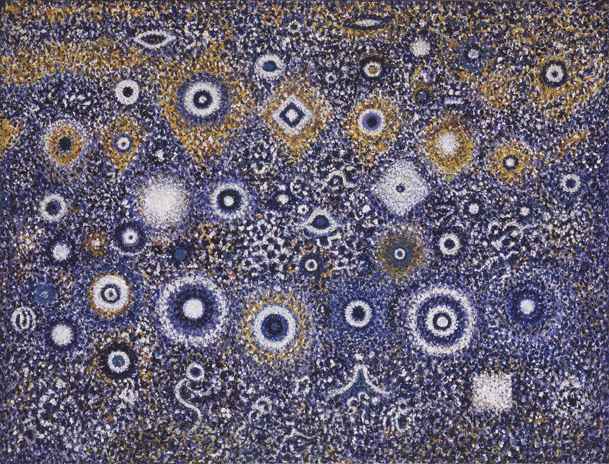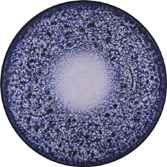Richard Poussette Dart (1916 Saint Paul, Minnesota - 1992 New York) was the youngest of the pioneering New York group of the Abstract Expressionists, active in New York from the early 1940s. Organized with the Estate of the Artist, and the artist's widow Evelyn Pousette-Dart, with the support of the American Contemporary Art Gallery, Munich, the exhibition presents 47 paintings, covering his entire career. It is the first retrospective to be held in Europe.
The New York School
Richard Pousette-Dart belongs to the first generation of the Abstract Expressionists and was a founding member of the so-called New York School, which included other great names of American Modernism such as Jackson Pollock, Mark Rothko and Willem de Kooning. Pousette-Dart and Adolph Gottlieb, in the same year, were the first to be given one-man shows, in 1941 at the Artists Gallery, New York. Peggy Guggenheim gave Pousette-Dart a solo exhibition in 1947 at her Art of This Century gallery, where the artist's best-known masterpiece, Symphony Number 1, The Transcendental . Metropolitan Museum of Art, New York, c. 1941-42), was shown for the first time. He made essential contributions to the nascent Abstract Expressionist movement. Between 1941 and 1942 he began painting outsize canvases, including Undulation (1941-42) on display in the exhibition, which anticipated Jackson Pollock's 'break-through' to mural-scale work in 1943.
Myth-Makers and Irascibles
Pousette-Dart's technique changed at this time, with an emphasis on matter, gesture and layering that were the first pictorial statements of what came to be known as 'action painting.' Crucifixion Comprehension of the Atom (1944) magnificently exemplifies this. Pousette-Dart's interest in ancient and Native American mythology and imagery, in works such Bird Woman. (1939-40) and Abstract Eye . (1941-43), as an image resource for the revelation of hidden truths, made him a leader among New York painters in the early 40s known as the “Myth-Makers.” In 1950 he was photographed together with 14 other Abstract Expressionist painters in an image that has entered the history books as the group of “The Irascibles.”
Illustration :Richard Pousette-DartLost in the Beginnings of Infinity1991
Acrylic on linen Diameter 72 in Private collection, Wien© Richard Pousette-Dart By SIAE, 2007
The spiritual nature of the universe
Pousette-Dart was considerably influenced by Oriental philosophy and American transcendental thinking.. The solitude he required for this life's work required him in 1951 to move out of New York. In 1958 he and his wife, the poet Evelyn Gracey, he, moved to the countryside near Suffern, New York, where his studio is still preserved today. Glowing and mysterious “white” paintings, c. 1950-51, include the masterpiece Pousette-Dart's work in the 1960s contributed to the color field and lyrical abstraction that were an important evolution of early Abstract Expressionism, with the added charge of the spiritual quest that runs like a continuous thread through all Pousette-Dart's work. They have titles evoking the magic of their radiant, pulsating and subtly colored surfaces such as Amaranth Garden, Night Landscape, Golden Presence, Byzantine Cathedral, and Lost in the Beginnings of Infinity. For Pousette-Dart, painting was a gradual and cumulative process revealing atavistic forms and symbols which became a visual metaphor and stimulus for understanding the complexity of Being. In 1947 he wrote “I strive to express the spiritual nature of the universe. Painting for me is a dynamic balance and wholeness of life; it is mysterious and transcending, yet solid and real.”
PUBLICATION
Exhibition catalogue, With essays by Kirstin Hübner and Lowery S. Sims, director of the Studio Museum in Harlem, New York, and a chronological biography by Enda Horgan. fully illustrated published by Skira, 35 €
Pousette-Dart's painting, together with that of his New York contemporaries such as Pollock, Arshile Gorky and William Baziotes, was first shown in Europe thanks to Peggy Guggenheim, when her collection was presented at the 24th Venice Biennale in 1948. His art has been exhibited in solo shows at the Museum of Modern Art, New York (1969-70), the Whitney Museum of American Art, New York (1963, 1974, 1998), the Museum of Art Fort Lauderdale, Florida (1986), the Indianapolis Museum of Art, Indiana (1990), the Detroit Institute of Arts (1991), the Columbus Museum, Columbus (1991-1992), the Metropolitan Museum of Art, New York (1997) and the Schirn Kunsthalle, Frankfurt (2001), the Los Angeles County Museum of Art (2006), the Fine Arts Museum, San Francisco (2006) and the Cincinatti Art Museum (2007).
|









